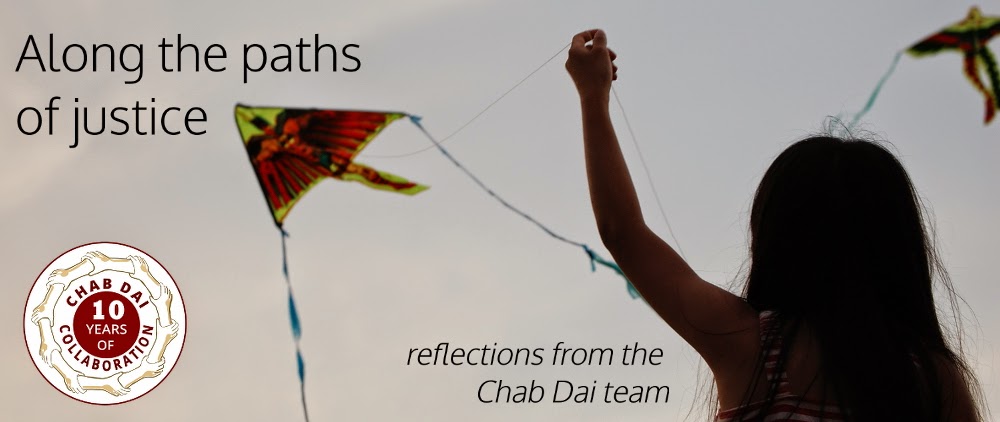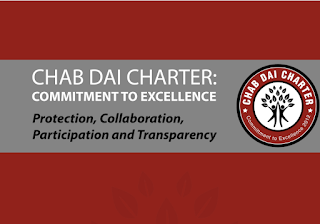Cambodia is
fortunate to have one of the most effective, unifying, impactful
anti-trafficking and sexual abuse coalitions in the world – the Chab Dai
Coalition. Well, I would say Chab Dai is the most effective, but I’m
biased! International Justice Mission Cambodia (IJM) has been fortunate to be
one of the original members of Chab Dai since its founding in 2005. I can’t
imagine the anti-trafficking movement in Cambodia without Chab Dai. Well, to be accurate, I was in Cambodia
before Chab Dai existed, so I actually knew what the movement was like without
Chab Dai, which increases my joy even more as we celebrate their 10-year anniversary.
 The value of looking back
The value of looking back
As member
agencies with powerful missions, facing urgent needs and engaging with
unimaginable violence, we often find ourselves primarily looking forward and
focusing on the pain of this world. But, God is clear that we are also to live
and serve in the disciplines of remembrance, thankfulness and celebration.
Remembering the faithfulness, gifts, miracles and progress from the past fuels
us with hope in the midst of our current battles and circumstances. Practicing
thankfulness brings peace and allows us to value others around us. When we
celebrate the victories – large and small – we infuse ourselves and our teams with
deep joy - a joy that would be impossible had we only focused on the deep pain
and need around us.
Human trafficking in Cambodia: 10 years ago
I remember what Cambodia was like the year Chab Dai Coalition started. I
remember the thousands of children being openly prostituted in brothels
that lined the streets of communities across the nation while traffickers,
pimps and business owners were raking in money. I remember criminals and
abusers who did not know the law, or what was right or wrong under the law. I
remember dozens of pedophiles walking the streets holding hands with the
children they planned to abuse, with no fear of being confronted or arrested.
I remember a decimated public justice system filled with officials who had
almost no training to do their jobs, felt ineffective to stop crime, were not yet
leading the anti-trafficking movement, and were sometimes even feared by the
very people who needed them the most. I remember a citizenry who did not
trust that their justice system could work for them, did not see the
media advocating for their protection, and did not know the law or their rights
under the law.
I remember a private aftercare system that was small, weak, uncoordinated,
with almost no best practice procedures in place and extremely low survivor
restoration rates. I remember NGOs who were not unified, not sharing or learning
with one another, but were desperate for support.
The impact of coalition
I am thankful that the founders of Chab Dai saw the reality of violence and
dysfunction, but had the vision to see what might be possible if they brought together like-minded organizations to provide shared learning, equipping,
guidance and best practice models.
I am thankful that Chab Dai created a forum for us to learn from, share with,
challenge, and encourage one another. I am thankful that this
collaborative learning environment has raised private aftercare’s quality of
service and protection to trafficking and sexual abuse survivors throughout the
nation.
I am thankful for healthy accountability, that we, as members, value and embrace
in order to be more competent, ethical, transparent, research-based and effective
in our work. I am thankful for Chab Dai’s innovation and vision to bring
unity to the movement in Cambodia and around the world through the Global Learning
Community and the Freedom Collaborative. I am thankful that Chab Dai
fills in vital gaps through their important research, hotline, community education,
and working together with the government.
A time to celebrate
I celebrate all the miracles that have happened in Cambodia over the past decade.
I celebrate that tens of thousands of Cambodian and Vietnamese citizens
have been educated, trained, and empowered, and now courageously identify
trafficking and abuse, report it, prevent it, and are growing in their trust
that their public justice system will respond to their cries for help.
I celebrate the hundreds of police officers, social workers, court officials
and community leaders who have been trained, equipped, and now confidently lead
the fight against trafficking. I celebrate the new laws, policies and procedures that have led to greater accountability, government leadership and
effectiveness.
I celebrate that the combined efforts of the public
justice system, community education, prevention programs and aftercare services have led to a decrease in prevalence of the commercial sexual exploitation of minors in the three provinces with the highest markets - from 15-30% of total sex workers in the early 2000s, down to around 2% today. And, the most significant decrease is the rate of young minors aged 15 and under in commercial prostitution - down to under .1%. Chab Dai members have been a part of bringing about all this change and progress, along with our government leaders and partners.
The
impossible is possible
What seemed
impossible 10 years ago has become possible. We can look back and see more
progress, more miracles, and more lives restored than we imagined. When we
choose to remember what was, we can see more clearly what is,
which gives us hope for what can be.
We are all working
to maintain and deepen the progress made in the fight against sex trafficking. We
are just starting to grow the movement to end labor and marriage
trafficking. And sexual abuse and
domestic violence are still at epidemic rates in Cambodia. But what we have all
seen is that justice for the poor is possible.
What has already been achieved in the fight against sex
trafficking can happen – and at even faster rates – in the battles that lay
before us, because lessons have been learned, the systems are stronger and the
government is leading the way. And,
as we have done for the past 10 years, we will do this together. In shared
learning. In unity. In accountability. In coalition.
Seek
the Lord and His strength; seek his presence continually. Remember the
wonderful works he has done, his miracles… Psalm 105:4-5a
What do you
remember as you think back over the past 10 years? What are you thankful for? What do you celebrate?
Thanks to Christa for writing this guest post. You can find the latest news on IJM projects in Cambodia and more about the organisation as a whole, over on their main website, www.ijm.org.
'Hands' image property of Chab Dai. All other images provided by IJM.



























.jpg)




.jpg)

